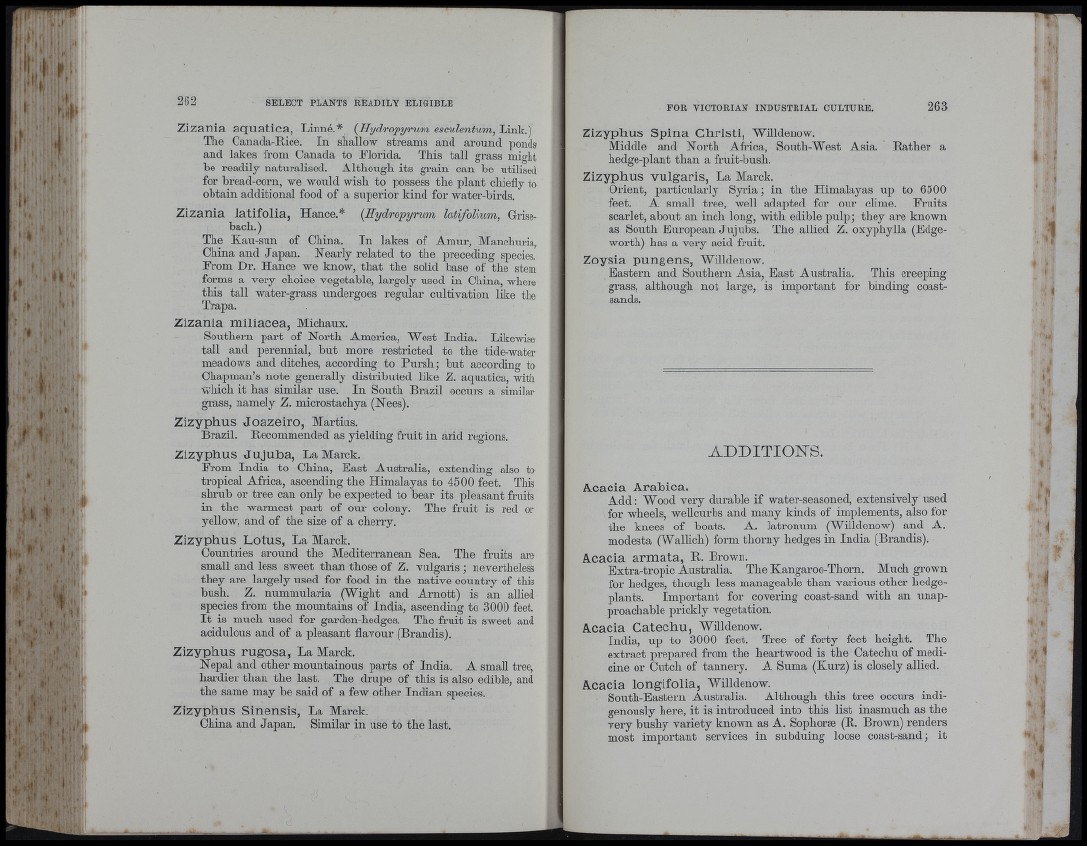
! f
' I r
t
t i
■1
t * î
1 - tl
Zizania aquatica, Linné.* {Hydropyrum escidentum, Link.)
The Canada-Rice. In shallow streams and around ponds
and lakes from Canada to Florida. This tall grass might
be readily naturalised. Although its grain can be utilised
for bread-corn, we would wish to possess the plant chiefly to
obtain additional food of a superior kind for water-birds.
Zizania latifolia, Hance.* [Hydropyrum latifolium, Grisebach.)
The Kau-sun of China. In lakes of Amur, Manchuria,
China and Japan. Nearly related to the preceding species.
From Dr. Hance we know, that the solid base of the stem
forms a very choice vegetable, largely used in China, where
this tall water-grass undergoes regular cultivation like the
Trapa.
Zizania miliacea, Michaux.
Southern part of North America, West India. Likewise
tall and perennial, but more restricted to the tide-Mmter
meadows and ditches, according to Pursh; but according to
Chapman’s note generally distributed like Z. aquatica, with
\Vhich it has similar use. In South Brazil occurs a similar
grass, namely Z. microstachya (Nees).
Zizyphus Joazeiro, Martius.
Brazil. Recommended as yielding fruit in arid regions.
ZizypBus Jujuba, La Marck.
From India to China, East Australia, extending also to
tropical Africa, ascending the Himalayas to 4500 feet. This
shrub or tree can only be expected to bear its pleasant fruits
in the warmest part of our colony. The fruit is red or
yellow, and of the size of a cherry.
Zizyphus Lotus, La Marck.
Countries around the Mediterranean Sea. The fruits are
small and less sweet than those of Z. vulgaris ; nevertheless
they ai-e largely used for food in the native country of this
bush. Z. nummularia (Wight and Arnott) is an allied
species from the mountains of India, ascending to 3000 feet.
I t is muck used for garden-hedges. The fruit is sweet and
acidulous and of a pleasant flavour (Brandis).
Zizyphus rugosa, La Marck.
Nepal and other mountainous parts of India. A small tree,
hardier than the last. The drupe of this is also edible, and
the same may be said of a few other Indian species.
Zizyphus Sinensis, La Marck.
China and Japan. Similar in use to the last.
Zizyphus Spina Christi, Willdenow.
Middle and North Africa, South-West Asia. Rather a
hedge-plant than a fruit-bush.
Zizyphus vulgaris. La Marck.
Orient, particularly Syiia; in the Himalayas up to 6500
feet. A small tree, well adapted for our clime. Fruits
scarlet, about an inch long, with edible pulp; they are known
as South European Jujubs. The allied Z. oxyphylla (Edge-
worth) has a very acid fruit.
Zoysia pungens, Willdenow.
Eastern and Southern Asia, East Australia. This creeping
grass, although not large, is important for binding coast-
sands.
ADDITIONS.
Acacia Arabica.
Add: Wood very durable if water-seasoned, extensively used
for wheels, wellcurbs and many kinds of implements, also for
the knees of boats. A. latronum (Willdenow) and A.
modesta (Wallich) form thorny hedges in India (Brandis).
Acacia armata, R. Brown.
Extra-tropic Australia. The Kangaroo-Thorn. Much grown
for hedges, though less manageable than various other hedge-
plants. Important for covering coast-sand with an unapproachable
prickly vegetation.
Acacia Catechu, Willdenow.
India, up to 3000 feet. Tree of forty feet height. The
extract prepared from the heartwood is the Catechu of medicine
or Cutch of tannery. A Suma (Kurz) is closely allied.
Acacia longifolia, Willdenow.
Soutk-Eastern Anstralia. Altkougk tkis tree occurs indigenously
kere, it is introduced into tkis list inasmuck as tke
very busky variety known as A. Sophorse (R. Brown) renders
most important services in subduing loose coast-sand; it